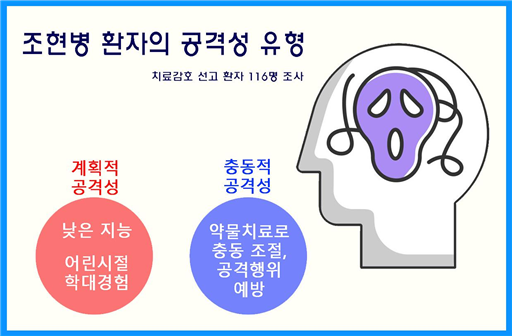
1. 조현병이란 무엇인가?
조현병은 정신질환의 일종으로, 현실과 상상의 경계가 흐려지는 증상을 보이는 질병입니다. 주로 환각, 망상, 사고의 흐름이 불연속적인 등의 증상이 나타나며, 사회적 기능 저하와 감정 조절의 문제도 동반될 수 있습니다. 조현병은 치료가 가능하며, 정기적인 약물 치료와 심리치료를 통해 증상을 완화시킬 수 있습니다.
2. 조현병의 정의와 특징 소개
조현병은 정신질환 중 하나로, 현실과 상상의 경계가 흐려지는 증상을 보이는 질병입니다. 주로 청소년기나 젊은 성인기에 발병하며, 대부분의 경우 유전적인 요인과 환경적인 요인이 복합적으로 작용하여 발생합니다. 조현병의 주요 특징은 환각, 망상, 정신분열 등이 있으며, 이로 인해 현실과의 연결이 끊어지고 사회적 기능이 저하될 수 있습니다. 조현병은 치료가 가능하며, 정기적인 약물 치료와 정신치료가 필요합니다. 또한 가족의 지원과 이해도 중요한 역할을 합니다. 이 글에서는 조현병의 정의와 특징에 대해 자세히 알아보겠습니다.
3. 조현병의 원인과 발생 메커니즘 설명
조현병은 정확한 원인을 알 수 없는 복잡한 신경정신질환입니다. 그러나 연구 결과, 유전적인 요인과 환경적인 요인이 조현병의 발생에 영향을 미칠 수 있다는 것이 밝혀졌습니다.
유전적인 요인은 조현병 발병 위험을 증가시킬 수 있습니다. 가족 중에서 조현병을 가진 사람이 있다면, 다른 가족 구성원들도 조현병에 걸릴 가능성이 높아집니다. 또한, 특정 유전자 변이도 조현병 발생과 관련이 있을 수 있습니다.
환경적인 요인도 조현병 발생에 영향을 줄 수 있습니다. 출생 시 합병증, 감염, 영양 결핍 등의 문제가 조현병 발병 위험을 증가시킬 수 있습니다. 또한, 스트레스, 약물 남용, 사회적 고립 등의 요인도 조현병 발생과 관련이 있을 수 있습니다.
조현병의 발생 메커니즘은 여전히 밝혀지지 않은 부분이 많습니다. 그러나 뇌의 화학 불균형과 신경전달물질의 이상이 조현병과 관련이 있다고 알려져 있습니다. 또한, 뇌의 구조적인 변화와 기능적인 이상도 조현병 발생과 연관이 있을 수 있습니다.
조현병의 원인과 발생 메커니즘에 대한 연구는 아직 진행 중이며, 더 많은 연구가 필요합니다. 이를 통해 조현병의 예방과 치료에 도움이 될 수 있는 방법을 찾을 수 있을 것입니다.
4. 조현병의 증상과 진단 방법
조현병은 정신질환 중 하나로, 현실과 상상의 경계가 흐려지는 증상을 보이는 질병입니다. 주요 증상으로는 환각, 망상, 사고의 혼란, 언어 및 사회적 기능의 손상 등이 있습니다. 이러한 증상들은 일상 생활에 큰 영향을 미치며, 환자의 사회적 관계와 일상 기능을 저하시킵니다.
조현병의 진단은 주로 증상의 유형과 기간, 환자의 가족력 및 병력 등을 고려하여 이루어집니다. 정신과 의사는 환자의 증상을 평가하고, 다른 질환과의 구별을 위해 신체적 검사와 신경심리학적 평가를 실시합니다. 또한, 조현병의 진단을 위해 환자의 가족 구성원들과의 인터뷰도 중요한 역할을 합니다.
조현병은 현재까지 완전한 치료법은 없지만, 적절한 약물 치료와 정신치료를 통해 증상의 완화와 재발 예방이 가능합니다. 또한, 가족의 지원과 교육, 환자의 일상 생활 관리 등이 중요한 치료 요소로 알려져 있습니다.
조현병은 치료를 받으면서도 일상 생활을 온전히 유지할 수 있는 질병이며, 조기에 적절한 치료를 받으면 예후가 좋아질 수 있습니다. 따라서, 조현병에 대한 정확한 이해와 조기 진단, 적절한 치료가 필요하며, 이를 위해 정신건강에 대한 사회적인 관심과 지원이 필요합니다.
5. 조현병의 주요 증상과 그에 따른 신체적, 정신적 변화 설명
조현병은 정신질환 중 하나로, 주로 정신적인 증상을 보이는 질병입니다. 이 질병의 주요 증상은 환각, 망상, 사고의 혼란, 언어 및 사고의 손상, 정서적 변화 등이 있습니다. 이러한 증상들은 환자의 일상 생활에 큰 영향을 미치며, 신체적인 변화도 동반될 수 있습니다. 조현병 환자는 체중 변화, 수면 장애, 식욕 변화 등을 경험할 수 있으며, 이는 약물 치료나 신체 활동의 감소로 인해 발생할 수 있습니다. 또한, 조현병은 환자의 사회적 관계와 일상 생활에도 영향을 미치며, 이로 인해 사회적 고립과 직장 등의 문제가 발생할 수 있습니다. 따라서, 조현병을 가진 환자들은 정기적인 치료와 관리가 필요하며, 가족의 지원과 이해도 중요합니다.
#조현병, #정신질환, #현실과상상의경계, #증상, #환각, #망상, #사고의흐름, #불연속적인, #사회적기능저하, #감정조절문제, #치료가능, #약물치료, #심리치료, #유전적인요인, #환경적인요인, #발병, #유전자변이, #출생시합병증, #감염, #영양결핍, #스트레스, #약물남용, #사회적고립, #뇌의화학불균형, #신경전달물질의이상, #뇌의구조적인변화, #기능적인이상, #진단, #약물치료, #정신치료, #가족의지원, #일상생활관리
1. What is Schizophrenia?
Schizophrenia is a type of mental illness, and it is a disease that shows symptoms in which the boundary between reality and imagination is blurred. Symptoms such as hallucinations, delusions, and discontinuous flow of thoughts appear mainly, and problems with social functioning and emotional control may also be accompanied. Schizophrenia is treatable, and symptoms can be relieved through regular medication and psychotherapy.
2. Introduction to the definition and characteristics of schizophrenia
Schizophrenia is one of the mental disorders, and it is a disease that shows symptoms that blur the boundary between reality and imagination. It usually occurs in adolescence or young adulthood, and in most cases, it is caused by a combination of genetic and environmental factors. The main features of schizophrenia include hallucinations, delusions, and schizophrenia, which can lead to disconnection from reality and reduced social functioning. Schizophrenia is treatable and requires regular medication and psychotherapy. Family support and understanding also play an important role. In this article, we will take a closer look at the definition and characteristics of schizophrenia.
3. Explanation of causes and mechanism of occurrence of schizophrenia
Schizophrenia is a complex neuropsychiatric disorder of unknown exact cause. However, research has shown that both genetic and environmental factors can influence the development of schizophrenia.
Genetic factors may increase the risk of developing schizophrenia. If someone in your family has schizophrenia, other family members are more likely to have schizophrenia. Additionally, certain genetic mutations may also be associated with developing schizophrenia.
Environmental factors may also influence the development of schizophrenia. Problems such as birth complications, infections, and nutritional deficiencies can increase the risk of developing schizophrenia. Additionally, factors such as stress, substance abuse, and social isolation may also be involved in developing schizophrenia.
The mechanisms by which schizophrenia develops are still largely unknown. However, it is known that brain chemical imbalances and neurotransmitter abnormalities are associated with schizophrenia. In addition, structural changes and functional abnormalities in the brain may also be associated with the development of schizophrenia.
Research into the causes and mechanisms of schizophrenia is still ongoing, and more research is needed. Through this, you will be able to find a way to help prevent and treat schizophrenia.
4. Symptoms and Diagnosis of Schizophrenia
Schizophrenia is one of the mental disorders, and it is a disease that shows symptoms that blur the boundary between reality and imagination. Major symptoms include hallucinations, delusions, confusion of thinking, and impairment of language and social functioning. These symptoms greatly affect daily life and impair the patient's social relationships and daily functioning.
Diagnosis of schizophrenia is mainly made by considering the type and duration of symptoms, the patient's family history and medical history, etc. Psychiatrists evaluate the person's symptoms and do a physical examination and neuropsychological evaluation to differentiate them from other disorders. Interviews with family members of the patient also play an important role in diagnosing schizophrenia.
Although there is no complete cure for schizophrenia, it is possible to alleviate symptoms and prevent recurrence through appropriate medication and psychotherapy. In addition, family support and education, and daily life management of patients are known to be important treatment factors.
Schizophrenia is a disease in which daily life can be maintained intact even with treatment, and the prognosis can be improved with early and appropriate treatment. Therefore, an accurate understanding of schizophrenia, early diagnosis, and appropriate treatment are required, and for this, social interest and support for mental health is required.
5. Describe the main symptoms of schizophrenia and the resulting physical and mental changes
Schizophrenia is one of the mental disorders, and it is a disease that mainly shows psychological symptoms. The main symptoms of this disease include hallucinations, delusions, confusion of thinking, impaired speech and thinking, and emotional changes. These symptoms greatly affect the patient's daily life and may be accompanied by physical changes. People with schizophrenia may experience weight changes, trouble sleeping, and changes in appetite, which may be caused by medication or reduced physical activity. Schizophrenia also affects the patient's social relationships and daily life, which can lead to social isolation and problems at work. Therefore, patients with schizophrenia need regular treatment and management, and family support and understanding are also important.
#schizophrenia, #mental disorder, #borderline between reality and imagination, #symptoms, #hallucinations, #delusions, #flow of thought, #discontinuous, #social dysfunction, #emotional control problems, #treatable, #medication , #psychotherapy, #genetic factors, #environmental factors, #onset, #genetic mutations, #birth complications, #infections, #nutritional deficiencies, #stress, #substance abuse, #social isolation, #chemical imbalances in the brain , #neurotransmitter abnormalities, #structural changes in the brain, #functional abnormalities, #diagnosis, #medication, #psychotherapy, #family support, #daily life management
1.チョ・ヒョンビョンとは何ですか?
チョヒョン病は精神疾患の一種で、現実と想像の境界がぼやける症状を示す病気です。主に幻覚、妄想、思考の流れが不連続であるなどの症状が現れ、社会的機能低下や感情調節の問題も伴うことがあります。チョヒョン病は治療が可能で、定期的な薬物治療や心理治療を通じて症状を緩和することができます。
2. チョヒョン病の定義と特徴紹介
チョヒョン病は精神疾患の一つであり、現実と想像の境界がぼやける症状を示す病気です。主に若年期や若い成人期に発症し、ほとんどの場合、遺伝的な要因と環境的な要因が複合的に作用して発生します。チョ・ヒョンビョンの主な特徴は幻覚、妄想、精神分裂などがあり、これにより現実との接続が切れ、社会的機能が低下することがあります。チョヒョン病は治療が可能で、定期的な薬物治療と精神治療が必要です。また、家族の支援と理解も重要な役割を果たします。この記事では、チョ・ヒョンビョンの定義と特徴について詳しく説明します。
3. 造弦病の原因と発生メカニズムの説明
チョ・ヒョン病は正確な原因が分からない複雑な神経精神疾患です。しかし、研究の結果、遺伝的要因と環境要因が造玄病の発生に影響を与える可能性があることがわかりました。
遺伝的要因は、造賢病の発症リスクを高める可能性があります。家族の中でチョ・ヒョンビョンを持っている人がいる場合、他の家族のメンバーもチョ・ヒョンビョンにかかる可能性が高くなります。さらに、特定の遺伝子変異も造癬病の発生と関連している可能性があります。
環境要因も造痕病の発生に影響を与える可能性があります。出生時の合併症、感染症、栄養不足などの問題は、造玄病の発症リスクを高める可能性があります。さらに、ストレス、薬物乱用、社会的孤立などの要因も、造玄病の発生と関連している可能性があります。
造弦病の発生メカニズムはまだ明らかになっていない部分が多い。しかし、脳の化学不均衡と神経伝達物質の異常が造玄病と関連があると言われています。また、脳の構造的な変化や機能的な異常も、造弦病の発生と関連がある可能性があります。
造賢病の原因と発生メカニズムの研究はまだ進行中であり、より多くの研究が必要です。これにより、チョヒョン病の予防と治療に役立つ方法を見つけることができます。
4. 造賢病の症状と診断方法
チョヒョン病は精神疾患の一つであり、現実と想像の境界がぼやける症状を示す病気です。主な症状には、幻覚、妄想、思考の混乱、言語や社会的機能の損傷などがあります。これらの症状は日常生活に大きな影響を与え、患者の社会的関係と日常機能を低下させます。
躁病の診断は、主に症状の種類と期間、患者の家族歴と病歴などを考慮して行われます。精神科医は患者の症状を評価し、他の疾患と区別するために身体検査と神経心理学的評価を行います。また、チョ・ヒョン病の診断のために患者の家族とのインタビューも重要な役割を果たします。
チョヒョン病は現在まで完全な治療法はありませんが、適切な薬物治療と精神治療を通じて症状の緩和と再発予防が可能です。また、家族の支援や教育、患者の日常生活管理などが重要な治療要因として知られています。
チョヒョン病は治療を受けながらも日常生活を完全に維持できる病気であり、早期に適切な治療を受けると予後が良くなることがあります。したがって、造賢病の正確な理解と早期診断、適切な治療が必要であり、そのためには精神健康に対する社会的な関心と支援が必要です。
5. チョヒョン病の主な症状とそれに伴う身体的、精神的変化の説明
チョヒョン病は精神疾患の一つで、主に精神的な症状を示す病気です。この病気の主な症状には、幻覚、妄想、思考の混乱、言語と思考の損傷、感情的な変化などがあります。これらの症状は患者の日常生活に大きな影響を与え、身体的な変化も伴うことがあります。躁病患者は体重の変化、睡眠障害、食欲の変化などを経験する可能性があり、これは薬物療法や身体活動の減少によって引き起こされる可能性があります。また、チョ・ヒョン病は患者の社会的関係や日常生活にも影響を与え、社会的孤立や職場などの問題を引き起こす可能性があります。このように、躁病を持つ患者は定期的な治療とケアを必要とし、家族の支援と理解も重要です。
#チョヒョン病、#精神疾患、#現実と想像の境界、#症状、#幻覚、#妄想、#事故の流れ、#不連続、#社会的機能低下、#感情調節問題、#治療可能、#薬物治療、#心理療法、#遺伝的要因、#環境要因、#発症、#遺伝子変異、#出生時合併症、#感染症、#栄養不足、#ストレス、#薬物乱用、#社会的孤立、#脳の化学的不均衡、#神経伝達物質の異常、#脳の構造的な変化、#機能的な異常、#診断、#薬物治療、#精神治療、#家族の支援、#日常生活管理



'잡학다식' 카테고리의 다른 글
| 서울의 대표적인 관광지 (1) | 2023.08.07 |
|---|---|
| 현대 소설과 전통 소설의 비교 / 현대 소설과 전통 소설의 비교 (0) | 2023.08.07 |
| 현대 사회에서의 정치적 양극화 (0) | 2023.08.06 |
| 확률과 통계의 기초 / 확률과 통계의 기초 (0) | 2023.08.06 |
| 살인 범죄의 정의와 종류 (0) | 2023.08.05 |



